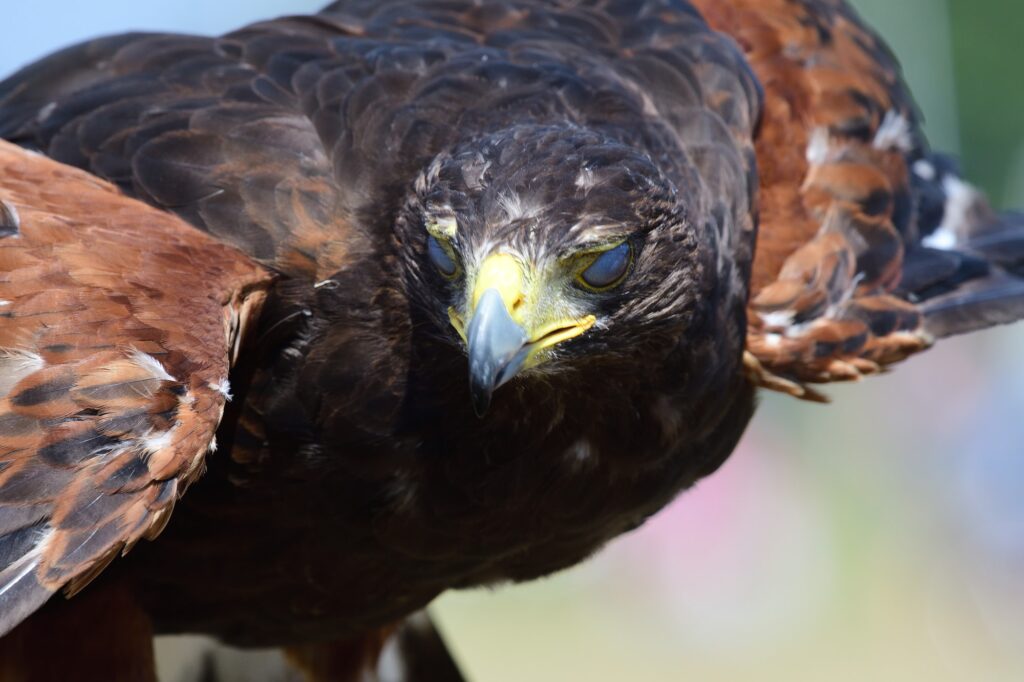Whether you’re an Ohio resident or simply going to visit the state, you’ll be amazed by the spread of wildlife there, especially birds.
According to the Ohio Ornithological Society, more than 400 different species of birds inhabit the Buckeye State. Some of these species live there all year long; some breed in it, while others migrate to or from it. This includes hawks, one of the most exciting bird species. Hawks are divided into two groups: accipiters and buteos. Luckily, the Ohio hawks are diverse enough for you to find members of both groups there.
In this article, we’re going to address the 10 species of hawks in Ohio, as well as how you can identify each.
Cooper’s Hawk

-
Scientific Name: Accipiter cooperii
-
Length: 14.6-17.7 inches
-
Weight: 7.8-24.0 ounces
-
Wingspan: 24.4-35.4 inches
You’ll find Cooper’s hawks in different parts of Ohio all year-round, though they usually prefer living in trees. However, you can also expect to find these birds of prey in your backyard hunting at bird feeders, so you should take the necessary measures if you catch sight of one, including taking your feeder down for two weeks or so to protect the small songbirds that may also stop by.
Cooper’s hawks are medium-sized birds with long and graduated tails and long legs. Adults of this species are blue-grey or brown-grey from the top, while the young ones are brownish.
One of the most distinctive features of Cooper’s hawks is their bright reddish eyes. However, these will be hard to spot while the hawks are in flight. This hawk is also a bit of a menace; they’ll hide in small places and take their victims by surprise.
Sharp-Shinned Hawk

-
Scientific Name: Accipiter striatus
-
Length: 9.4-13.4 inches
-
Weight: 3.1-7.7 ounces
-
Wingspan: 16.9-22.1 inches
Northern Ohio is a non-breeding zone for some sharp-shinned hawks, so they’re only there during the fall. However, you’ll find other sharpies inhabiting Ohio year-round, usually living in forests.
Many people confuse Cooper’s hawks and sharp-shinned hawks since they’re so similar in shape, color, and manner, but sharp-shinned hawks are smaller than Cooper’s bird. Like their larger lookalikes, adult sharp-shinned hawks have blue-gray heads while those of juveniles are brown, and as they grow, their breasts turn orange; that doesn’t happen for their fellow Cooper accipiters.
Thanks to their small size, sharp-shinned hawks can take their prey by surprise, which is especially helpful as they hunt at bird feeders. If you notice a sharpie flitting about in your backyard, take your feeder down for a few weeks to protect the other little birdies that stop by. They don’t just eat other birds, though. These petite hunters’ diet also includes rodents, squirrels, and large insects.
Broad-Winged Hawk
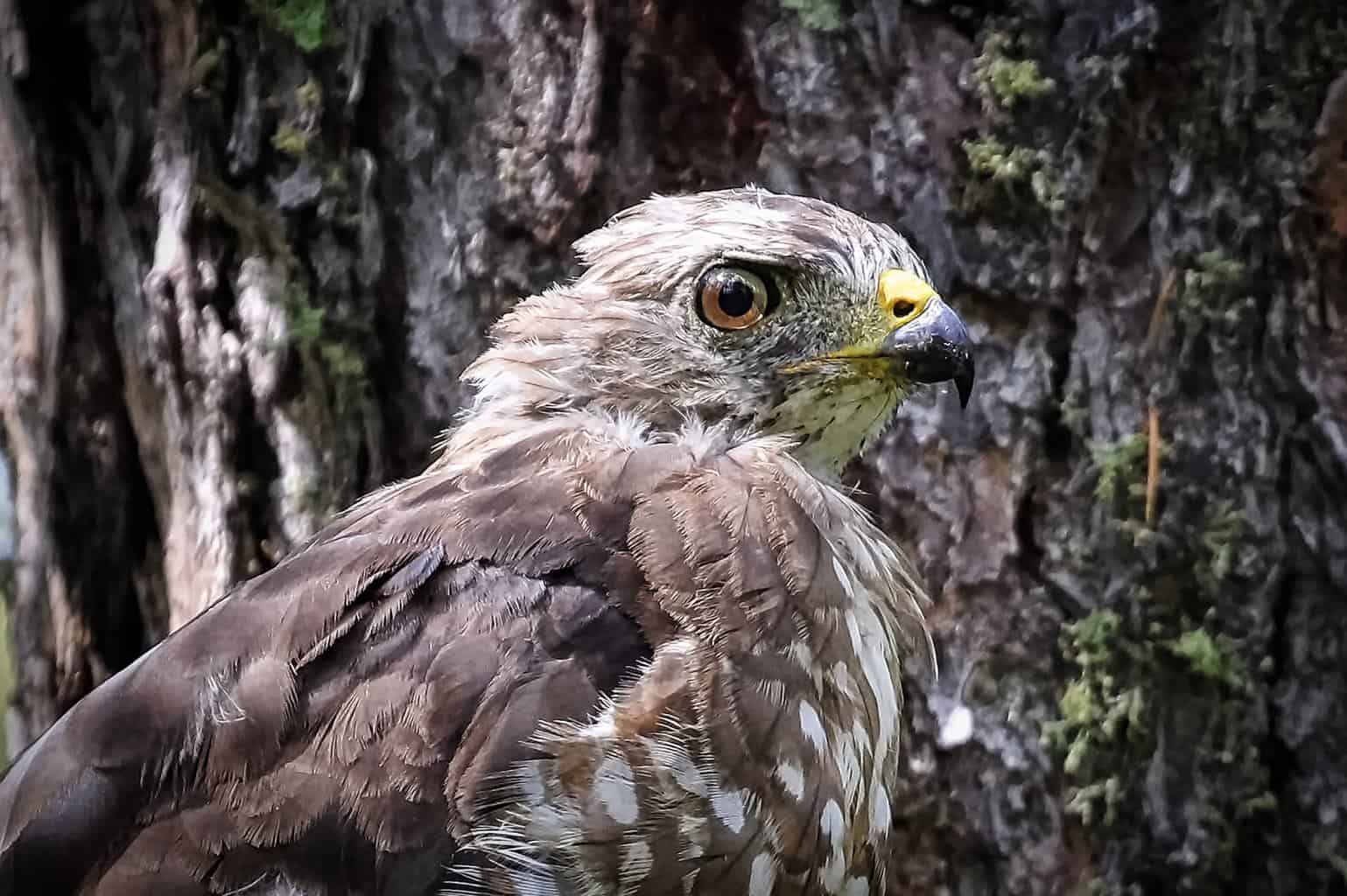
-
Scientific Name: Buteo platypterus
-
Length: 13.4-17.4 inches
-
Weight: 9.3-19.8 ounces
-
Wingspan: 31.9-39.4 inches
Because broad-winged hawks only go to Ohio to breed, you’ll find them in spring and summertime. They take residence mostly in wooded areas and near water sources, and they’re more widespread in southern parts of the state.
Adults of this hawk species have large reddish-brown heads, while juveniles have light brown heads. In typical buteo fashion, the broad-winged hawks’ tails are squared, and their bodies are a little chunky.
Broad-winged hawks are social birds that migrate in enormous groups. They also have a high-pitched whistle that you can identify them by. It usually lasts from 2-4 seconds, and it’s very distinct, so listen carefully if you hope to hear it.
Red-Tailed Hawk

-
Scientific Name: Buteo jamaicensis
-
Length: 17.7-25.6 inches
-
Weight: 31.8-51.5 ounces
-
Wingspan: 44.9-52.4 inches
Red-tailed hawks are the most widespread hawk species in Ohio, and you’ll find these agile hawks there the whole year. They prefer flying over open fields, prairies, and marches, but you may also find them standing on utility poles as they wait for their next meal to come along.
The red-tailed birds prey on a wide range of animals, including voles, rats, rabbits, small birds, amphibians, and reptiles (especially snakes).
Red-tailed hawks are the second-largest North American hawks, and while their heads are a rich brown, their bottoms are pale. And of course, just as their names indicate, they sport reddish tail feathers. Dark morphs of this species are chocolate-brown colored.
You just might hear this bird before you see it, as red-tailed hawks also have a unique, loud cry, which is usually the one you hear in movies when an eagle or hawk appears onscreen.
Red-Shouldered Hawk
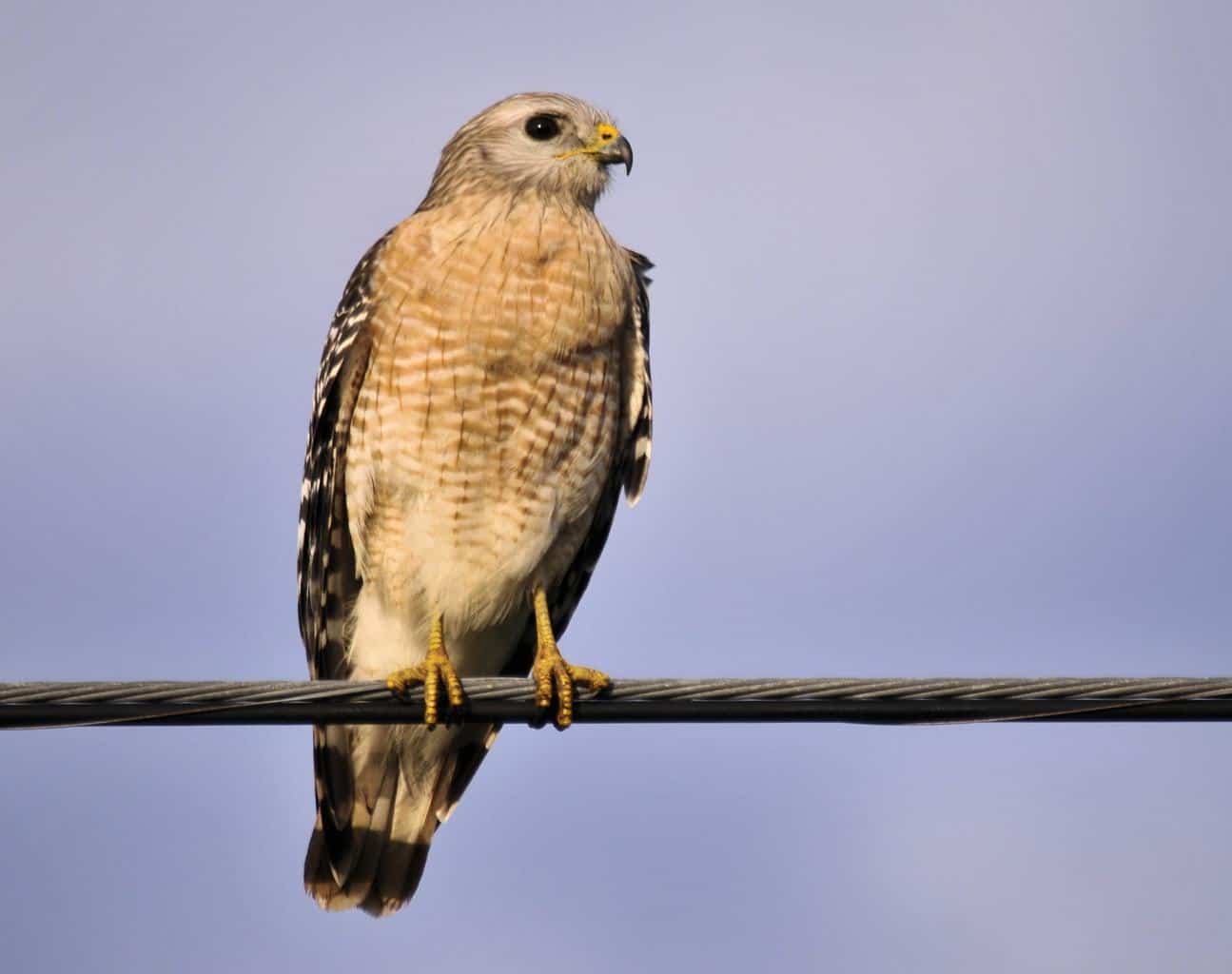
-
Scientific Name: Buteo lineatus
-
Length: 16.9-24.0 inches
-
Weight: 17.1-27.3 ounces
-
Wingspan: 37.0-47.3 inches
No matter when you find yourself in Ohio, your chances of spotting red-shouldered hawks are pretty high. They usually inhabit swamps and trees — especially dead ones — in forest areas.
Red-shouldered hawks are relatively big, and their wings are round and broad. As the name suggests, the feathers on their breast and shoulder areas are reddish, and their wings are dark and white. However, while the adults are this colorful, the juveniles are only brown and white. What’s interesting about red-shouldered hawks is that their color changes according to their location, so they are a lighter hue in Ohio.
Red-shouldered hawks make great use of their hearing while hunting, unlike most hawks. They also have a special kee-rah cry that you’ll be able to identify quickly.
Swainson’s Hawk

-
Scientific Name: Buteo swainsoni
-
Length: 18.9-22.1 inches
-
Weight: 24.4-48.2 ounces
-
Wingspan: 45-56 inches
As Swainson’s hawk only shows itself in Ohio during its breeding season, you’ll probably have a hard time locating this bird in this state. Don’t lose hope, though. During the spring and summer, you just might find one of them perched on the ground, utility posts, or fences.
Male Swainson’s hawks have grey heads, while those of females are brown. They also have light bellies, reddish-brown chests, broad wings, and large tails.
Swainson’s hawks are social birds that usually travel in big flocks. And unlike most hawks, which prefer to spot their prey while flying, these birds like to search for their prey on the ground. They like to hunt small mammals, amphibians, reptiles, and other species of birds.
Northern Goshawk

-
Scientific Name: Accipiter gentilis
-
Length: 20.9-25.2 inches
-
Weight: 22.3-48.1 ounces
-
Wingspan: 40.5-46.1 inches
While some northern goshawks head to Ohio to spend their winters in the state, others breed there. They’re rarely found in the south; instead, they mostly occupy the northern portion of the state where they frequent forests and woodland areas.
With their long tails and rounded broad wings, these raptors are the largest accipiters, and females are even larger than males! They have gray heads, orange-red eyes, and a white stripe around the eye that looks a bit like an eyebrow. While juveniles, on the other hand, are covered in brown feathers and have yellow eyes, they still sport the same white “eyebrow” as their elders.
Northern goshawks are some of the best hunters among hawks. They tend to stalk their prey from afar and quickly attack them when the opportunity strikes, so smaller birds and mammals should stay on high-alert when these stealthy predators are nearby.
Northern Harrier

-
Scientific Name: Circus hudsonius
-
Length: 18.1-19.7 inches
-
Weight: 10.6-26.5 ounces
-
Wingspan: 40.2-46.5 inches
Some people believe that northern harriers only migrate from Canada to the south, including Ohio, in the winter. However, traces of northern harriers were found in Ohio in spring and summer, so these birds may be around the midwestern state more often than you’d think.
Like many species of hawks, northern harriers like open spaces, so look for them in meadows, fields, and prairies. They’re hard to come across in a backyard, but if you’re lucky, you just might spot one there.
Northern harriers resemble owls in both looks and behavior, as they also depend on their hearing when hunting. They have broad wings and rounded tails. Males have grey heads, white bottoms, black wing edges, and black-banned tails. Females, as well as immatures, are brown with the same black bands on the tail.
Rough-Legged Hawk
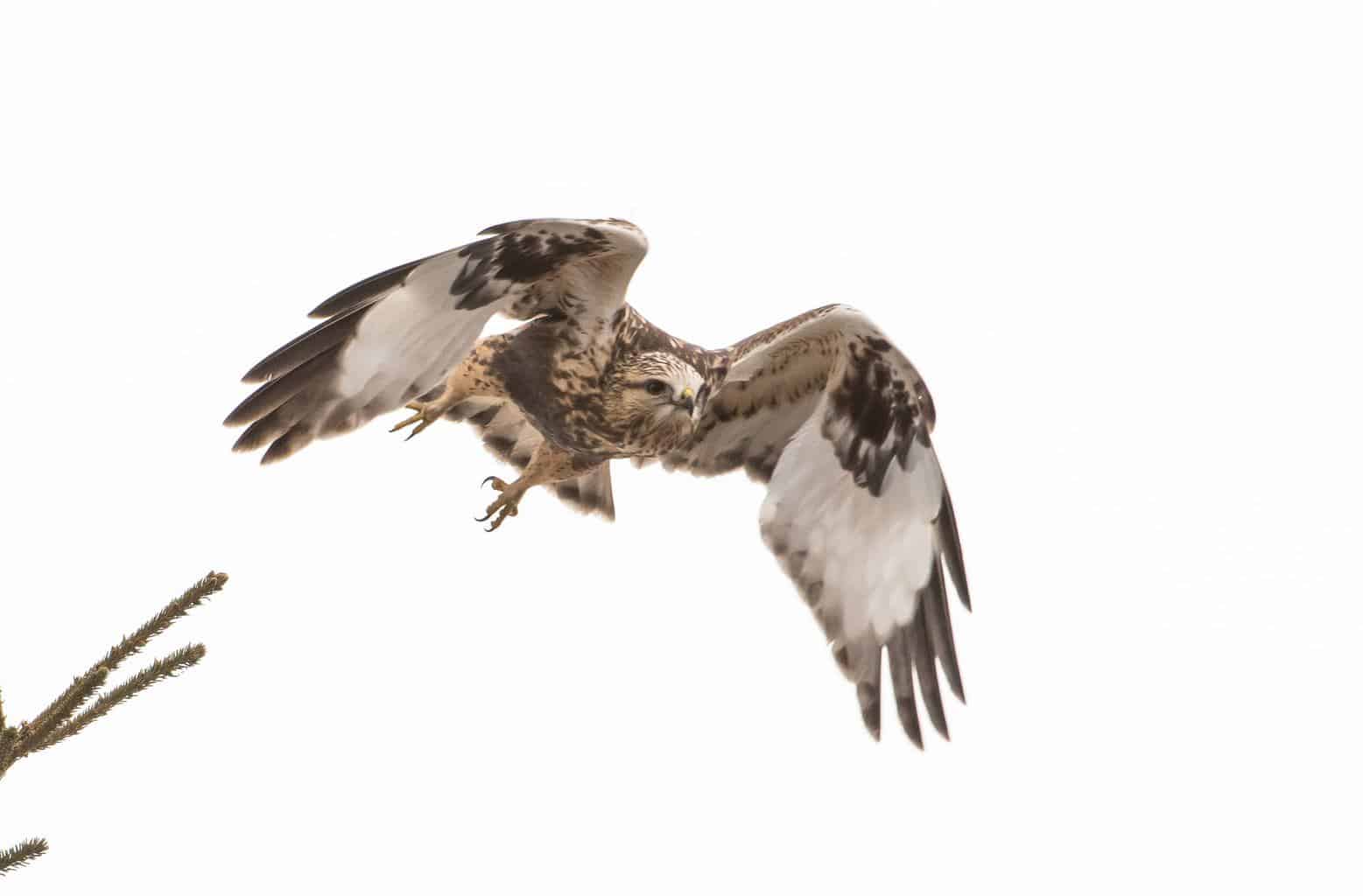
-
Scientific Name: Buteo lagopus
-
Length: 18.5-20.5 inches
-
Weight: 25.2-49.4 ounces
-
Wingspan: 52.0-54.3 inches
To help these hawks better adapt to their arctic tundra breeding grounds, the rough-legged hawks’ legs are covered in feathers that grow down to their feet, a physical trait shared only with the golden eagle and ferruginous hawk.
Their breeding habitat causes this species to migrate to open fields in Canada and the U.S., including Ohio. Since they love open spaces, you’ll most likely find them in prairies and meadows.
Rough-legged hawks are large and have broad, long wings. Light morph rough-legged hawks are mostly white with dark wing edges and dark bellies in females. Dark morphs, on the other hand, are mostly brown with white wing edges.
Harris’s Hawk
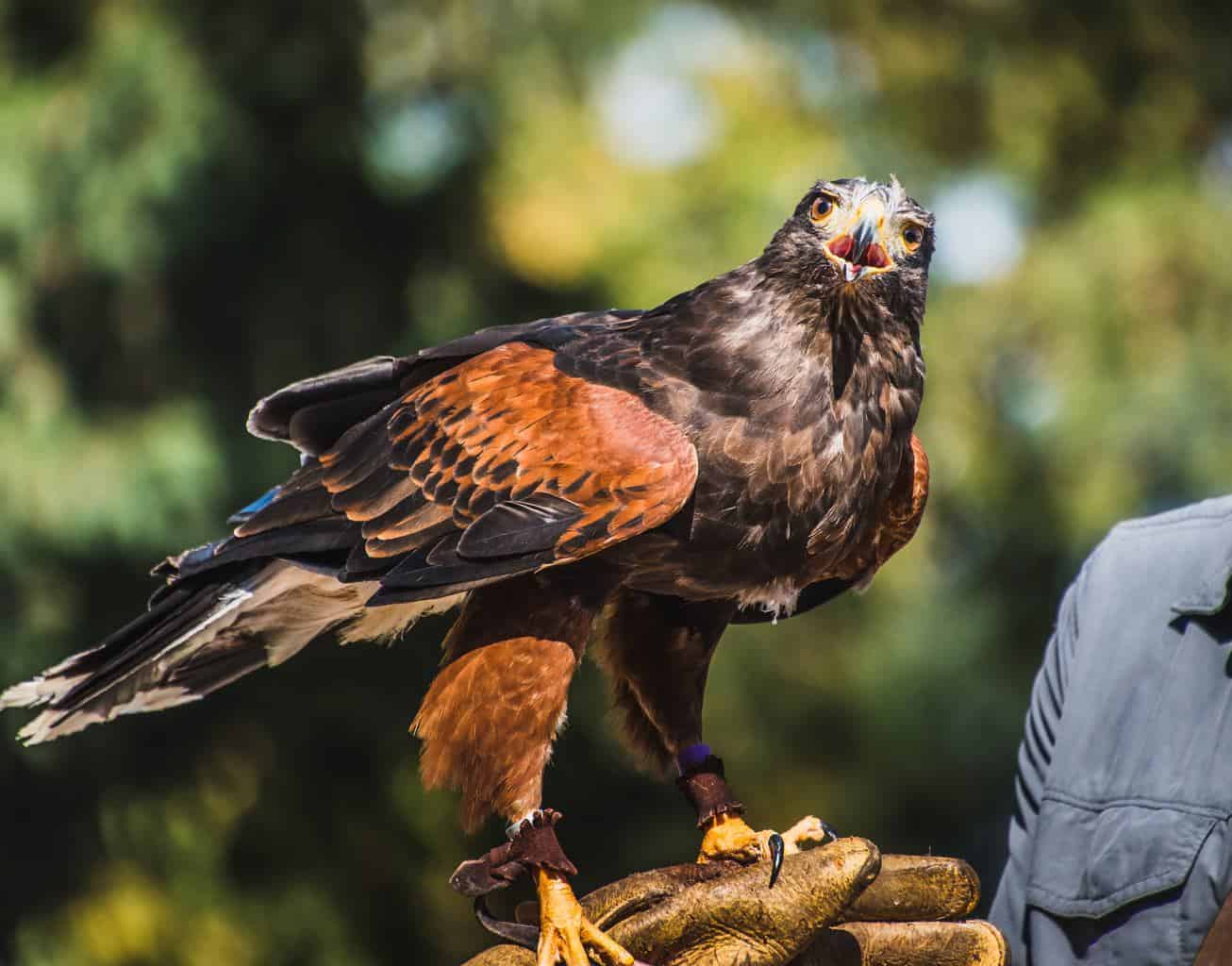
-
Scientific Name: Parabuteo unicinctus
-
Length: 18.1-23.2 inches
-
Weight: 18.2-31.0 ounces
-
Wingspan: 40.5-46.9 inches
Harris’s hawks are quite rare in Ohio, but you’ll sometimes find them in the state’s southern deserts. Unfortunately, there’s no information about when they can be found, which suggests that they might migrate to Ohio by accident.
If you do find one of Harris’s hawks, it’ll probably be in an open place on a telephone pole or something similar it can perch on, or maybe on the ground. This is another social species that hunt in flocks.
Harris’s hawks are large with long tails and legs as well as broad, rounded wings. They’re mostly brown with some reddish feathers on the wings, and their tails are dark with white edges. Baby birds of this species are the same colors as adults but have white feathers on their bellies and wings instead.
Conclusion
Watching hawks in their natural habitats can teach you determination, confidence, and concentration, as they’re a species that puts a lot of effort into setting a strategy to hunt their prey.
Hawks aren’t just present in Ohio; you’ll also be able to find various species of hawks in other American states, like Georgia.
If you’d like to know more about other birds in this part of the country, check out this article about the woodpeckers that live in Ohio!

